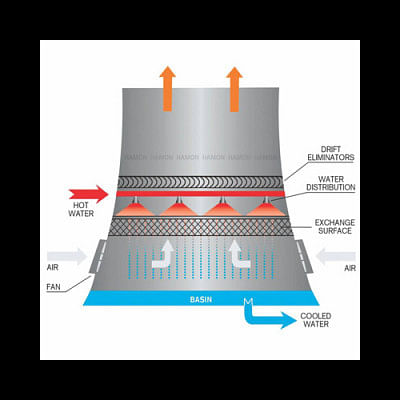A challenge for Rooppur nuclear power plant

The proposed Rooppur nuclear power plant (RNPP) stands on the river Padma. Insufficient water in Padma will require the power plant to adopt re-circulatory condenser water cooling system to convert the used steam of turbines into water. The main devices on the system are the cooling towers where the condenser water gets cooled by evaporation of water in contact with moving air. Air absorbs heat from water and rejects to atmosphere. As cooling tower performance is greatly influenced by ambient condition, RNPP will face a great challenge to select the right type and size of towers which can handle the huge quantity of water under high ambient temperature.
Air wet bulb temperature is the most important factor for cooling tower, because it is the minimum temperature that water can achieve through evaporation. In fact water can only be cooled near to wet bulb temperature at any weather condition. This is the reason why cooling towers are designed based on wet bulb temperature.
The peak summer condition at Rajshahi (a nearby city) is 39.5°C db and 29.2°C wb (source BNBC 2006) will be applicable for Rooppur. 29.2°C≈ 85°F is a very high wet bulb temperature for a cooling tower. The higher the wet bulb temperature, the larger will be the size of tower. Therefore, cooling towers in Bangladesh will be much bigger in size than those in countries of America and Europe where the wet bulb temperature is in the range of 75°F to78°F.
Suitable towers for RNPP
Parabolic (or hyperboloid) cooling tower, a tall and round structure with slight convergence in the middle, is so common a view that it has become an icon of nuclear power plants. Fan assisted parabolic towers may be a suitable choice for RNPP (refer to images). Because, the parabolic towers will handle huge quantity of water and the forced draft fans will supply the required air flow.
An added advantage is that the recirculation of hot air will not take place as it will be discharged at high level. A typical parabolic tower of 180m height can handle 170,000 cum/hr of condenser water. The quantity of condenser water flow for a tower of RNPP will be around 97,200 cum/hr. and is well within limit of capacity of available tower in the market. For 2000 MW plant, 4 nos. cooling towers are required. It will be wise to provide one more cooling tower as standby for convenience of maintenance. The towers may be sized for 10 percent more water flow for a factor of safety.
Cooling water treatment
The turbid river water will need pre treatment before it is filled in the cooling system. Continuous evaporation in towers will leave behind soluble salts in the cooling water. These salts deposit as scales in condenser tubes and resist heat transfer. As a remedy, anti-scaling and anti-corrosion chemicals are to be added to maintain the chemistry of water within allowable limit. To reduce the concentration of dissolved salts, blow down is to be carried out on regular basis and refilled by fresh water. Make up water will be automatically fed in by a float valve which will open and close when the water in tower bed reaches the set levels.
Also biocides are to be applied regularly to prevent the growth of algae and bacteria in cooling towers because microbiological fouling also hampers the heat transfer.
Impact on the environment
It is a fact that Legionella, a very harmful bacteria thrives in cooling towers. Tiny water droplets carrying this bacteria are airborne to the nearby localities and spread pneumonia and acute respiratory diseases. It is a known negative impact of cooling towers on the environment and public health when due attention is not given for tower maintenance during plant operation. It can be prevented by application of biocide chemicals and regular cleaning of towers.
Judicious selection of the type and size of cooling towers cannot be overemphasised. The output of the power plant is dependent on cooling water temperature. One degree hotter cooling water will reduce turbine output by about one percent. Concrete cooling towers are permanent in nature and will last throughout the plant life. Ceramic tile fills are more durable and is preferable to PVC fills. As the towers will be built and erected at site, its final performance is to be tested during peak summer season. The test is to be conducted and certified by an internationally reputed third party agent. However, it is never wise to compromise the quality and size of towers on the ground of cost saving.
..................................................................
The writer is a senior mechanical engineer.
Email: [email protected]

 For all latest news, follow The Daily Star's Google News channel.
For all latest news, follow The Daily Star's Google News channel. 



Comments